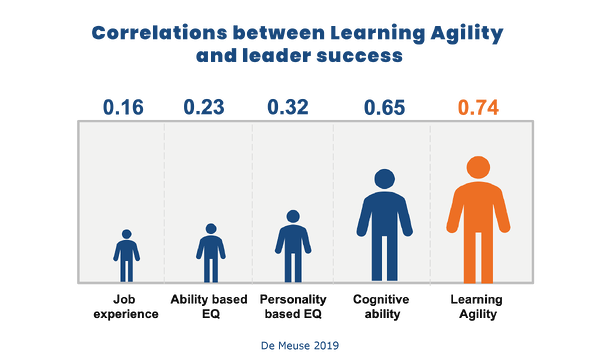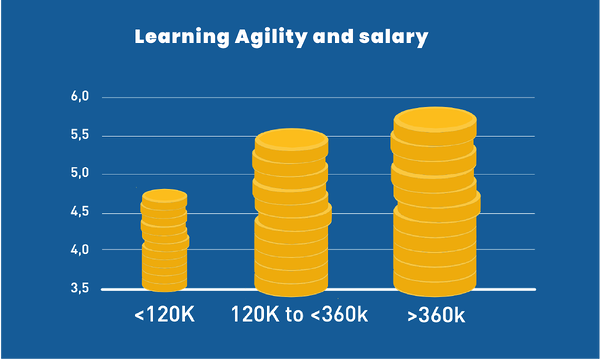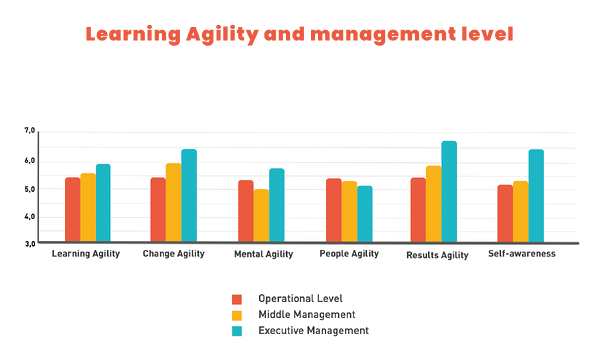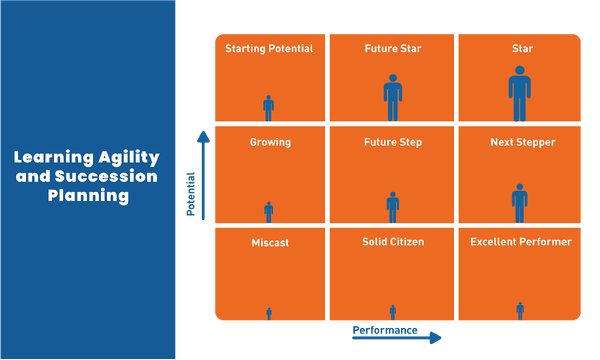The Business Case for Learning and Leadership Agility
Learning Agility enables organisations to define, measure, understand and develop how effectively its people respond to change and new demands. This includes changes brought about by new job roles, new responsibilities, new technologies and more.
Research supports the important role of Learning Agility in organisational, team and individual performance. We’ve summarised some of these key findings below, highlighting why it’s critical for your business to measure and grow its Agility.
Research shows that Learning Agility is the Strongest Predictor of Leadership Potential and Performance
More than half of leaders' success is linked to their Learning Agility (54.76% to be precise). These were the peer-reviewed findings published by Dr de Meuse in the Journal of Organizational Psychology (2019). He conducted a meta-analysis into 20 separate studies on Learning Agility and found a 0.74 correlation between Learning Agility and leadership performance.
Putting this into context, when looking at what drives success in leaders, Learning Agility accounts for 54% of the performance puzzle. This is statistically stronger than the relationship seen with other attributes commonly used in selection and promotion, such as educational history (1%), previous job experience (3.2%), emotional intelligence (10%) and cognitive ability (42%).
Bringing more Learning Agility through the front door, promoting Learning Agility higher in the organisation, and developing Learning Agility are thus crucial ways to increase the effectiveness of leadership.

Learning Agility Pays Better
People with higher Learning Agility tend to earn more than their peers. In a study into the Learning Agility of HR professionals in South Africa, we found that as salary increased, so did Learning Agility. However, this effect starts to flatten after salaries get above R360k and Learning Agility moves to the above average range.

Learning Agility Takes Careers Further
Learning Agility goes hand in hand with career success. This is illustrated by the findings from the Lumenii global Learning Agility study, which shows that senior managers and executives typically have higher Agility than admin, professional and junior staff. In other words, as you move up in seniority, Agility increases.

In another longitudinal study at PEP, leaders with higher Learning Agility experienced twice the positive career mobility than their peers.

Learning Agility Drives Succession
People with higher Learning Agility are promoted sooner. In succession planning programmes, there is a clear relationship between the 9-box matrix and Learning Agility. Those who are Stars (top right, high potential and performance) are more likely to have significantly higher Learning Agility. In contrast, those who are possible Miscasts for the role (bottom left, low potential and performance) demonstrate the lowest Agility overall.
As employees move through the matrix and become more “succession ready”, we see a clear positive correlation with Learning Agility.

Learning Agility Drives Change
The data shows that senior managers and high potentials generally have higher Learning Agility than the rest. Interestingly, they typically don’t have the highest Agility in any organisation.
When we surveyed the general population, we learned that another group of people has even higher Agility: Change Agents. When you ask who really makes the difference and drives organisations forward, this remarkable group of people has the highest Learning Agility.
Learning Agile Teams Perform Better
While there is a strong link between the Learning Agility of an individual and their success, the relationship between the Learning Agility of a team and the team’s effectiveness is even more vital.
It’s worth investing in the whole team’s Learning Agility. Research shows that higher Agility results in better team performance. Keep in mind that you can’t build the Agility of a team by increasing the Agility of one or two people. In high-performing teams, we find most people need above-average Learning Agility. Learning Agile teams are the engines of successful organisations.
Interested in finding out more about Learning Agility and Leadership Agility for your business? Request a demo and we’ll be in touch.

Author
Lumenii's team of expert psychologists regularly collaborate to share their ideas and knowledge. The latest case studies, thought leadership, and research.